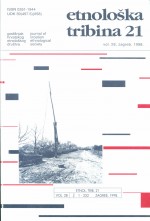Etnokulturni razvoj Hrvata u Slovačkoj
The Ethnocultural Development of Croatians in Slovakia
Author(s): Ján BotíkContributor(s): Iva Niemčić (Translator), Adela Böhmerovä (Translator)
Subject(s): Modern Age, Cultural Anthropology / Ethnology, Social development, 16th Century, 17th Century, Migration Studies, Ethnic Minorities Studies
Published by: Hrvatsko etnološko društvo
Keywords: Croats; Slovakia; Ethno-cultural development;
Summary/Abstract: Croatians are one of the stones in the mosaic creating the ethnic structure of Slovakia. They became incorporated into it at the beginning of the 16th century. Croatians in Slovakia are part of a more extensive island which was formed on the territory around the shared borderlines of contemporary Austria, Hungary, Slovakia and Bohemia. The arrival of Croatian colonizers to Slovakia resulted not only in the domestication of their ethnonym (Horvat) which is also contained in the names of several communities and in the surnames of many families, but also of their language, above all colloquial in the form of the chakavian and kajkavian dialects. In most communities inhabited by the Croatians the Croatian language stopped to be used within the 17th to 19th centuries. At present, Croatian has been preserved only in Jarovce, Čunovo, Devinska Nova Ves and Chorvatsky Grob. From the period of the 16th to 18th centuries there exist historical documents of the work of Croatian priests and teachers. It is only in Jarovce and Čunovo where Croatian as a language used in liturgy and education has been preserved as long as up to the 20th century. The national and cultural presence of the Croatians in Slovakia is in an important way documented by various religious books and school textbooks in Croatian published in the cultural centers of the Burgenland Croatians (Eisenstadt, Gyor, Sopron and others). These centers also provided stimuli for various collections of Croatian religious manuscripts, namely pilgrim songs and prayers. In the community of Jarovce, from the period of the end of the 19th century and the beginning of the 20th century there have also been preserved Croatian manuscripts describing various aspects of the economic, social and spiritual life of the local Croatians. Further phenomena characterized by the continual existence and preservation of certain specific Croatian features are folk songs connected with some traditional festivals and family ceremonies. These are proved by melodies with an archaic musical structure which do not exist in the repertoire of Slovak songs. Ethnically specific features have also been found within some parts of the traditional male and female clothes of Croatians in Slovakia. The contemporary period can be characterized by a certain renaissance of the Croatian ethnics in Slovakia. This is manifested in various forms of searching for roots, formulating one’s identity, as well as in reviving the cultural, social and political activities of the adherents of the Croatian community in Slovakia.
Journal: Etnološka tribina : Godišnjak Hrvatskog etnološkog društva
- Issue Year: 28/1998
- Issue No: 21
- Page Range: 35-43
- Page Count: 9
- Language: Croatian

